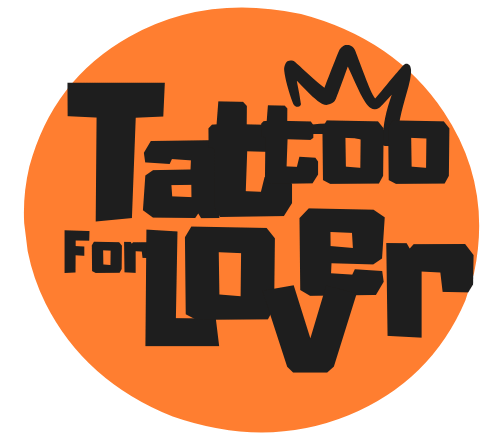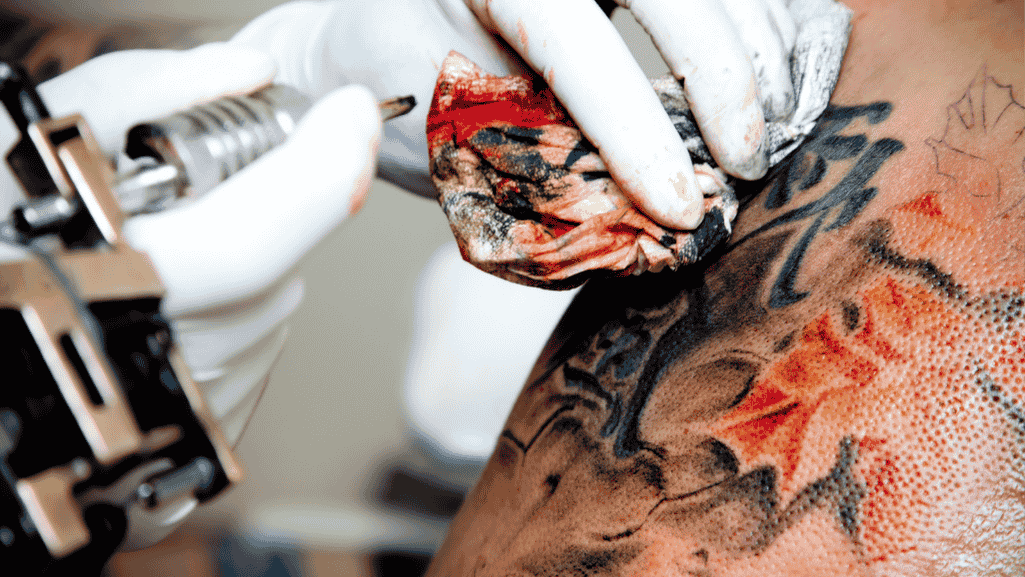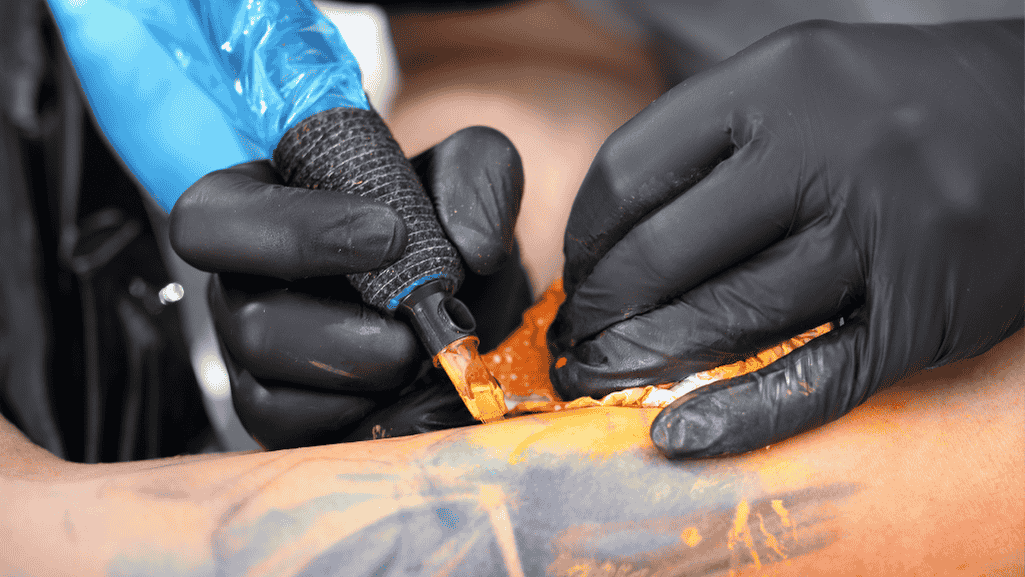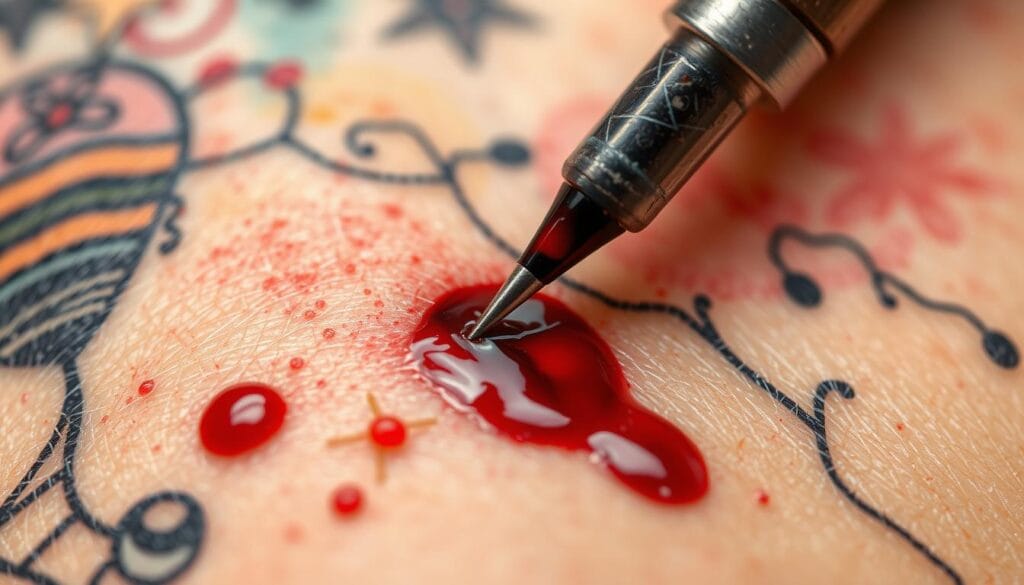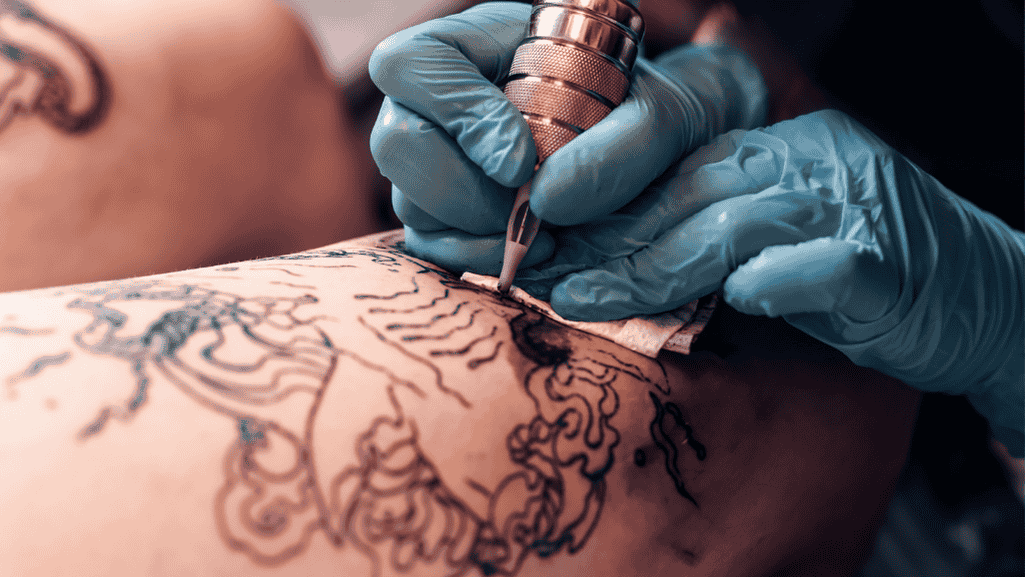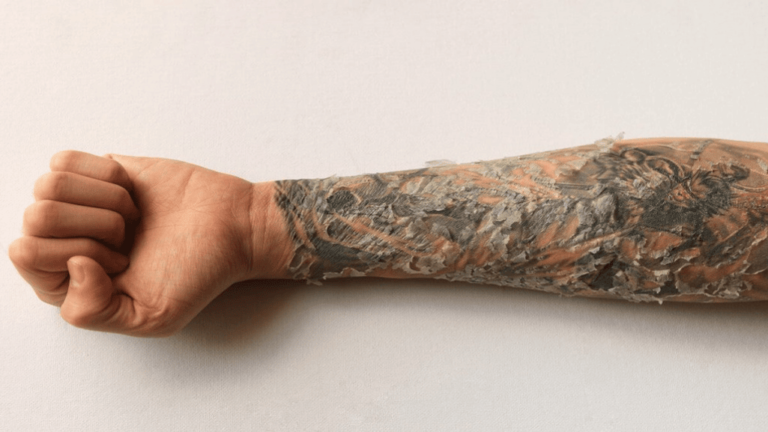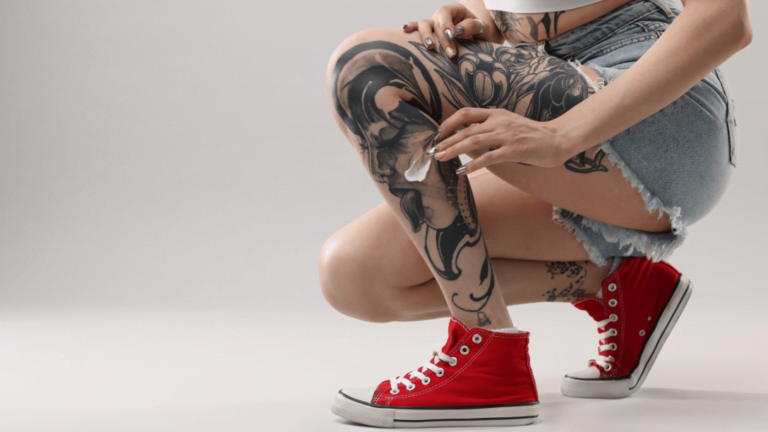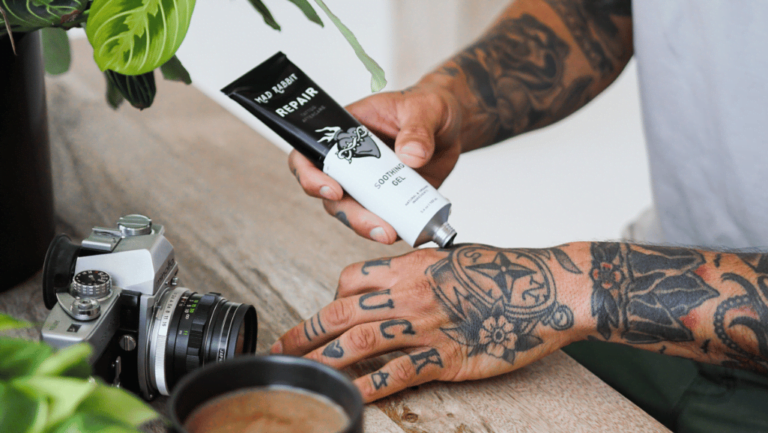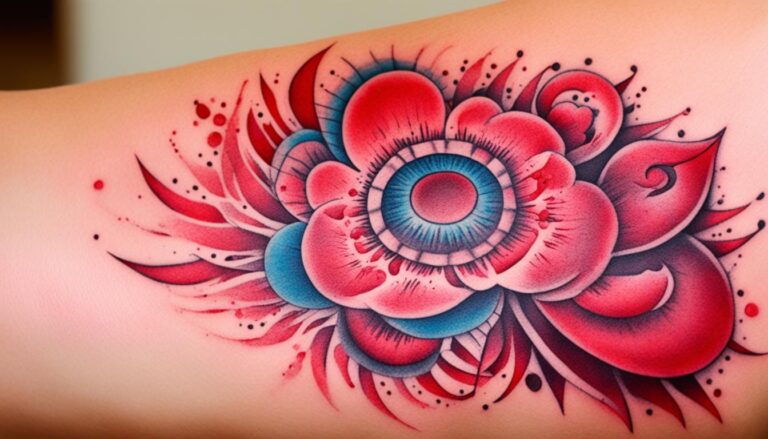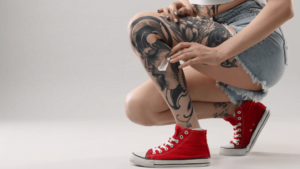Getting a new tattoo is exciting, but it’s key to know bleeding is normal. When needles inject ink into the skin, it causes trauma. This leads to bleeding tattoos. The bleeding can change based on the tattoo’s location, size, and your skin’s sensitivity. Why Do Tattoos Bleed?
Seeing your tattoo bleed might worry you, but it’s common and usually stops within 48 hours. Your tattoo artist will give you aftercare tips. These help manage bleeding and ensure your tattoo heals right.
Key Takeaways
- Bleeding is a normal part of the tattooing process and healing
- Tattoo needles cause trauma to the skin, leading to bleeding
- The amount of bleeding varies based on tattoo location, size, and individual skin sensitivity
- Tattoo bleeding typically lasts no more than 48 hours
- Proper aftercare helps manage bleeding and ensures optimal healing
The Tattooing Process and Bleeding
The tattooing process uses special needles to put ink into the skin, making a permanent design. Some bleeding happens as the needles go through the skin, causing minor damage. Knowing how tattoo needles work with the skin helps prepare for getting a tattoo.
How Tattoo Needles Penetrate the Skin
Tattoo artists use a machine with needles that move fast, puncturing the skin. These needles are in groups, changing the line thickness and shading. The needles go deep into the skin, creating small wounds in the dermis layer.
Tattoo Ink Injection and Skin Trauma
When the needles go through the skin, they also put tattoo ink into the dermis layer. This process causes controlled damage to the skin, starting the healing process. The body’s response includes more blood flow, which can lead to bleeding.
Bleeding is normal during tattooing, but too much or lasting bleeding can be a sign of trouble. Tattoo artists must be careful to avoid too much damage and ensure a clean tattooing experience.
Normal Bleeding During and After Tattooing
When you get a new tattoo, some bleeding is normal. This happens because the needles cause small wounds in your skin. Knowing what to expect can help you take good care of your tattoo.
Bleeding During the Tattoo Session
Bleeding is common when you get a tattoo. The needles make small wounds that bleed. How much you bleed can depend on where your tattoo is, how sensitive you are, and how big it is.
Post-Tattoo Bleeding and Oozing
After your tattoo, it might bleed for a few days. This is normal and helps it heal. You might also see plasma and ink coming out, which is called weeping. This usually stops after three days.
To deal with bleeding and oozing, follow good tattoo aftercare. Keep it wrapped for 6 hours, then wash it with special soaps. Avoid alcohol and blood thinners, and don’t exercise too much.
Duration of Normal Tattoo Bleeding
Bleeding from a new tattoo usually gets less over time. The weeping stage ends after 2-3 days. If it keeps bleeding a lot, see a doctor.
| Tattoo Bleeding Stage | Duration | Characteristics |
|---|---|---|
| During Tattoo Session | Throughout the session | Normal bleeding caused by needle punctures |
| Post-Tattoo Bleeding | 1-3 days after session | Continued bleeding, considered normal |
| Weeping Stage | First 3 days after session | Mixture of blood, plasma, and excess ink oozing |
| Gradual Decrease | 2-3 days after session | Bleeding subsides as tattoo heals |
Understanding normal bleeding and following aftercare is key. If you’re unsure, ask your tattoo artist or a doctor.
By taking care of your tattoo, it will heal well. This way, your tattoo will look great for a long time.
Tattoo Healing Stages and Bleeding
The healing of a tattoo goes through several stages. Each stage has its own signs and risks of bleeding. Knowing these stages helps you know what’s normal and what might need medical help.
Right after getting a tattoo, it will look red, swollen, and sore. This usually lasts 48 to 72 hours. You might see blood and ink coming out, which is okay as your body heals.
As the tattoo heals, between days 4 and 14, the skin might peel, flake, and scab. You might also feel itchy. Some scabbing is normal, but too much or bleeding could mean trouble. It’s important not to scratch or pick at scabs to avoid losing ink and scarring.
| Tattoo Healing Stage | Duration | Characteristics |
|---|---|---|
| Initial | Days 1-3 | Redness, swelling, tenderness, oozing of blood and/or ink |
| Peeling and Scabbing | Days 4-14 | Skin peeling, flaking, scabbing, itching |
| Visible Healing | Days 14-30 | Visible signs of healing resolve, tattoo may appear dull and dark |
| Full Healing | 1-3 months | Tattoo assumes its final form, complete healing |
By the third week, most healing signs should be gone. But the tattoo might look dull and dark until about a month later. A tattoo usually looks complete in a month for a young, healthy person. But, it takes about three months to fully heal.
Proper aftercare is key for a tattoo to heal well and avoid problems. Keep it clean, moisturized, and away from irritants and sun.
Tattoos with lots of color take longer to heal because of more needle pricks. This causes more inflammation. Also, daily care is important. If your tattoo doesn’t get better or shows signs of infection, see a doctor.
Knowing about tattoo healing stages and bleeding helps you watch your tattoo’s healing. This way, you can make sure it heals well.
Factors Affecting Tattoo Bleeding
Bleeding is a normal part of getting a tattoo. Several factors can change how much and how long you bleed during and after. Knowing these can help you prepare for your tattoo and understand the healing process better.
Tattoo Location and Skin Thickness
The tattoo’s location on your body affects bleeding. Thinner skin areas like the feet, ankles, and inner arms bleed more. They have less fat and are closer to bones, making them more sensitive and prone to bleeding.
Tattoo Size and Complexity
Bigger and more detailed tattoos bleed more than smaller ones. They need longer sessions, causing more skin trauma. This leads to more bleeding and oozing as they heal. Tattoos with lots of shading or color also cause more damage, leading to more bleeding.
Individual Skin Sensitivity and Healing
Everyone’s skin reacts differently to tattoos. Some people’s skin is more sensitive, leading to more bleeding. Age, health, and genetics also play a role in how well you heal and how long you bleed.
| Factor | Impact on Tattoo Bleeding |
|---|---|
| Tattoo Location | Areas with thinner skin (feet, ankles, inner arms) are more prone to bleeding and blowouts |
| Tattoo Size and Complexity | Larger and more complex tattoos result in more bleeding due to increased skin trauma |
| Individual Skin Sensitivity | People with more sensitive skin may experience increased inflammation and bleeding |
| Healing Abilities | Factors such as age, health, and genetics can impact the body’s ability to heal and affect bleeding duration |
Understanding these factors can help you know what to expect with bleeding during and after your tattoo. While some things like location and size can be controlled, others like skin sensitivity are unique. Talking to a professional tattoo artist can make your experience more informed and comfortable.
Excessive Tattoo Bleeding and Complications
Some bleeding is normal when you get a tattoo. But too much bleeding can be a problem. It might mean you have an infection or are allergic to the ink. Knowing the signs of too much bleeding helps you get medical help fast. This ensures your tattoo heals right.
Signs of Excessive Bleeding
Too much bleeding from a tattoo lasts more than 48 hours. It’s heavy and doesn’t stop with pressure. If this happens, talk to your tattoo artist or a doctor. Ignoring it can ruin your tattoo’s look and cause more problems.
Tattoo Infections and Bleeding
Infections can make your tattoo bleed a lot. They happen if the tattooing isn’t clean or if you don’t take care of it right. Look out for redness, swelling, discharge, and pain. Untreated infections can be serious.
Seeking medical help quickly is key to managing infections. Studies show how important it is to take care of your tattoo and get help when needed.
Ink Allergies and Bleeding
Allergic reactions to tattoo ink can also cause bleeding. You might itch, get rashes, or feel skin irritation. These can happen right after or years later. If you think you have an allergy, see a dermatologist.
They can figure out what’s causing it and suggest how to treat it. Allergic reactions can make your tattoo look raised. So, getting medical help for unusual symptoms is crucial.
| Tattoo Removal Method | Bleeding Risk |
|---|---|
| Q-switched Lasers | Higher potential for bleeding due to high-energy pulses |
| Phantom™ Laser Removal | Shorter, targeted laser energy may reduce bleeding risk |
| Lasers with Longer Wavelengths | Increased bleeding risk compared to lasers targeting lighter colors |
Size, location, and skin sensitivity also play a part in bleeding risk. Bigger tattoos, certain spots, and sensitive skin might bleed more. To avoid this, take care of your skin and follow aftercare tips. This helps your tattoo heal better and reduces bleeding risk.
why do tattoos bleed
Getting a tattoo means putting ink into the skin’s dermis layer with a needle. This action hurts the skin, causing it to bleed and ooze. The body reacts by getting inflamed, which is key to healing.
Tattoo Needle Trauma and Skin Injury
A tattoo artist uses a needle to poke the skin many times, putting ink in the dermis. This makes many small injuries to the skin, damaging blood vessels and starting inflammation. How much trauma happens depends on the tattoo’s size, where it’s located, and the person’s skin type.
Inflammatory Response and Bleeding
When the skin is hurt by the needle, the body starts to heal by getting inflamed. This brings more blood to the area, bringing nutrients and oxygen to the damaged skin. This blood flow makes the tattoo bleed and ooze, mixing blood, plasma, and extra ink. This is a normal part of healing, helping to clean the tattoo.
Ink Leakage and Plasma Oozing
As the tattoo heals, it often bleeds and oozes blood, plasma, and ink. This is the body’s way of getting rid of foreign stuff and cleaning the wound. This usually happens in the first few days and gets better as the tattoo heals. Keeping the area clean and following aftercare tips helps prevent infection and aids in healing.
According to a study published in the Journal of Clinical and Aesthetic Dermatology, about 70% of people experience tattoo bleeding and oozing when they first get a tattoo. Most cases clear up in 3-7 days.
| Tattoo Bleeding Duration | Percentage of Individuals |
|---|---|
| 1-3 days | 45% |
| 4-7 days | 25% |
| More than 7 days | 5% |
| No bleeding reported | 25% |
In short, tattoos bleed because of the skin injury from the needles, which causes inflammation. This inflammation brings more blood, making the tattoo leak plasma and ink as it heals. While some bleeding is normal, too much or lasting too long might mean there’s a problem and should be checked by a doctor.
Tattoo Aftercare and Bleeding Management
Proper tattoo aftercare is key to managing bleeding and healing. Following your tattoo artist’s advice and caring for your tattoo can prevent problems. This ensures your tattoo heals well.
Proper Tattoo Bandaging and Wrapping
Your artist will cover your tattoo with a bandage after the session. This protects it and absorbs fluids like blood and ink. It’s important to follow their advice on when to remove the bandage, usually after 6 hours. Keeping the tattoo wrapped helps prevent infection and aids in tattoo blood clotting.
Cleaning and Moisturizing the Tattoo
After removing the bandage, clean the tattoo with fragrance-free soap and lukewarm water. Dry it gently with a soft towel and apply a thin layer of fragrance-free moisturizer. Avoid petroleum-based products and harsh chemicals. Cleaning and moisturizing help manage tattoo weeping and reduce scabbing.
| Aftercare Step | Frequency | Duration |
|---|---|---|
| Cleaning | 2-3 times daily | First 2 weeks |
| Moisturizing | 2-3 times daily | First 2 weeks |
| Bandaging | As needed | First few days |
Avoiding Irritants and Blood Thinners
To reduce bleeding and aid healing, avoid irritants and blood thinners. Important tattoo care tips include:
- Avoid direct sunlight and tanning beds
- Wear loose, breathable clothing over the tattoo
- Avoid swimming, soaking, or submerging the tattoo in water
- Refrain from picking or scratching the tattoo, even if it itches
- Avoid alcohol, aspirin, and other blood-thinning substances
“Tattoo plasma weeping and excess ink loss are normal parts of the healing process. By following proper aftercare instructions, you can minimize these issues and ensure your tattoo heals beautifully.” – Experienced Tattoo Artist
Everyone’s skin heals differently, and bigger or more complex tattoos may need more time. If you see a lot of bleeding, signs of infection, or have healing concerns, talk to your tattoo artist or a healthcare professional.
When to Seek Medical Attention for Tattoo Bleeding
Some bleeding is normal when a tattoo is healing. But, if your tattoo bleeds a lot for more than 48 hours, you should see a doctor. This could mean an infection or an allergic reaction to the ink.
Look out for signs of infection like redness, swelling, warmth, and discharge. In serious cases, an infection can cause fever, chills, and even sepsis. If you think your tattoo is infected, get medical help fast to avoid more harm.
Also, watch for signs of an allergic reaction to the tattoo ink. This can include itching, rash, or trouble breathing. If you see any of these signs, especially if they spread or affect your breathing, go to the emergency room right away.
It’s important to know the risks of tattoos and watch your healing closely. If you’re worried about bleeding, infection, or allergic reactions, talk to your tattoo artist or a doctor. Quick medical help can prevent problems and help your tattoo heal right.
According to a recent study, around 4 in 10 Americans now have one or more tattoos, and while they are becoming less controversial in many industries, it’s crucial to prioritize safety and proper aftercare to avoid complications.
To keep your tattoo safe and healthy, follow these tips:
- Keep the tattoo clean and dry, gently washing it with a mild soap and lukewarm water.
- Apply a thin layer of moisturizer to prevent the tattoo from drying out and cracking.
- Avoid picking at scabs or peeling skin, as this can interfere with the healing process and increase the risk of infection.
- Stay hydrated and maintain a balanced diet to support your body’s natural healing abilities.
Proper aftercare is key for tattoo healing. Getting medical help when needed can help avoid problems and ensure your tattoo looks great. If you’re thinking about getting a tattoo, choose a reputable artist who follows safety rules. This way, you can enjoy your tattoo while keeping your health safe. For more info on tattoo bleeding and healing, check out H2Ocean’s guide on what you need to know about your tattoo.
Remember, while tattoos are permanent, temporary options like henna tattoos are safer for those unsure about permanent tattoos. But, even with temporary tattoos, it’s important to use safe, non-toxic materials to avoid bad reactions.
| Symptom | Possible Cause | Action |
|---|---|---|
| Excessive bleeding lasting more than 48 hours | Infection, allergic reaction, or underlying health condition | Seek medical attention |
| Redness, swelling, warmth, and discharge | Tattoo infection | Consult a healthcare professional |
| Itching, rash, or difficulty breathing | Allergic reaction to tattoo ink | Seek emergency medical care |
Knowing when to seek medical help can protect your health and ensure your tattoo heals well. Always choose caution and seek advice if unsure. This way, you can avoid tattoo bleeding and promote healthy healing.
Preventing Excessive Tattoo Bleeding
Some bleeding is normal when getting a tattoo. But too much can cause problems and slow healing. To avoid this, follow these steps for a smooth healing process.
Choosing an Experienced Tattoo Artist
Choosing a skilled tattoo artist is key to avoiding too much bleeding. A good artist uses clean equipment and follows safety rules. They also know how to care for your skin type.
Look for artists with great portfolios and good reviews. Ask them about their experience and safety practices. A quality artist is an investment in your tattoo’s health.
Following Proper Aftercare Instructions
After your tattoo, follow your artist’s aftercare advice. This includes:
- Gently clean the tattoo with mild soap and lukewarm water twice a day
- Pat the tattoo dry with a clean towel
- Apply a thin layer of moisturizer to keep it hydrated
- Avoid direct sunlight and water until healed
- Wear loose, breathable clothes to avoid irritation
By following these tattoo care tips, your tattoo will heal well and bleed less.
Avoiding Blood Thinning Substances
Stay away from blood-thinning substances before and after your tattoo. They can make bleeding worse and slow healing.
Some things to avoid include:
- Alcohol
- Aspirin and NSAIDs
- Herbal supplements like ginkgo biloba, garlic, and ginger
- Prescription blood thinners (check with your doctor)
Avoid these for 24-48 hours before and after your tattoo to prevent bleeding and promote healing.
Minimizing Skin Irritation and Trauma
Minimizing skin irritation and trauma helps prevent bleeding and speeds healing. This includes:
- Avoid strenuous activities for 48 hours after your tattoo
- Keep your tattoo away from sunlight
- Wear loose clothes to avoid rubbing
- Don’t pick or scratch your tattoo
By avoiding irritation and trauma, your tattoo will heal better and bleed less. Proper aftercare is crucial for your tattoo’s health and longevity.
While tattoo bleeding is normal, taking precautions and following aftercare can reduce bleeding and ensure a smooth healing process.
Tattoo Blowouts and Bleeding
Tattoo blowouts happen when ink goes too deep into the skin. This makes the tattoo blurry or smudged. It can hurt more, swell, and bleed during healing. Parts like wrists, fingers, and knees are more likely to get blowouts because they move a lot.
Too much pressure or bad ink can cause blowouts. Different inks react differently to skin. It’s important to take good care of your tattoo to avoid blowouts.
Although there is limited recourse once a blowout occurs, options may include getting laser removal of the tattoo or having a tattoo artist rework the design to minimize the visibility of the blowout.
Telling your tattoo artist about blowouts helps them improve. Skin problems like psoriasis can hurt a lot during tattooing. Blood thinners make bleeding worse. Cold or heat can slow down tattoo healing, and tight clothes can cause color loss.
| Tattoo Location | Blowout Risk | Maintenance Difficulty |
|---|---|---|
| Wrists, Fingers | High | High |
| Ribs, Hips | Moderate | Moderate |
| Elbows, Knees, Feet | High | High |
Hand, foot, and finger tattoos fade fast because the skin sheds. Pregnancy and breastfeeding slow down tattoo healing. Women should wait 6 months after pregnancy to get a tattoo. Fine line tattoos on fingers and feet fade quickly and need a skilled artist.
Conclusion
Tattoo bleeding is a normal part of healing. The amount of bleeding can change based on the tattoo’s size, location, and your skin. It’s also influenced by the tattoo artist’s skill.
Some bleeding is okay, but too much or signs of infection need medical help. It’s important to take care of your new tattoo right.
After getting a tattoo, keep it covered overnight. This prevents stains on clothes or bedding. For 2 to 6 weeks, clean it gently with mild soap and moisturize as needed.
Avoid soaking the tattoo, swimming, or sweating too much. Knowing how to care for your tattoo helps it heal well. If you have concerns, talk to your tattoo artist or a doctor.
With the right care, your tattoo will heal beautifully. It will be a lasting piece of art for you.
FAQ
Is it normal for tattoos to bleed during and after the tattooing session?
What factors can affect the amount of bleeding during and after tattooing?
How long does normal tattoo bleeding last?
What are the signs of excessive tattoo bleeding?
How can I manage tattoo bleeding during the healing process?
When should I seek medical attention for tattoo bleeding?
How can I prevent excessive tattoo bleeding?
Can tattoo blowouts cause excessive bleeding?
Forhad
Forhad's writing is not just about the artistry of tattoos or the latest trends in the industry; it's an exploration of the deep-rooted connections people have with their tattoos, reflecting personal narratives, cultural histories, and moments of transformation. Through a mix of in-depth features, personal narratives, and insightful analyses, he sheds light on the multifaceted nature of tattooing, revealing the emotional and cultural layers that lie beneath the surface.

